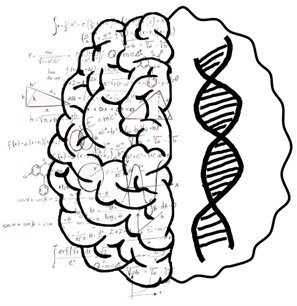DNA variation in a gene called ROBO1 is associated with early anatomical differences in a brain region that plays a key role in quantity representation, potentially explaining how genetic variability might shape mathematical performance in children, according to a study published October 22nd in the open-access journal PLOS Biology by Michael Skeide of the Max Planck Institute for Human Cognitive and Brain Sciences, and colleagues. Specifically, the authors found that genetic variants of ROBO1 in young children are associated with grey matter volume in the right parietal cortex, which in turn predicts mathematical test scores in second grade.
Mathematical ability is known to be heritable and related to several genes that play a role for brain development. But it has not been clear how math-related genes might sculpt the developing human brain. As a result, it is an open question how genetic variation could give rise to differences in mathematical ability. To address this gap in knowledge, Skeide and his collaborators combined genotyping with brain imaging in unschooled children without mathematical training.
The authors analyzed 18 single nucleotide polymorphisms (SNPs) -genetic variants affecting a single DNA building block—in 10 genes previously implicated in mathematical performance. They then examined the relationship between these variants and the volume of grey matter (which mainly consists of nerve cell bodies), across the whole brain in a total of 178 three- to six-year-old children who underwent magnetic resonance imaging. Finally, they identified brain regions whose grey matter volumes could predict math test scores in second grade.
They found that variants in ROBO1, a gene that regulates prenatal growth of the outermost layer of neural tissue in the brain, are associated with the grey matter volume in the right parietal cortex, a key brain region for quantity representation. Moreover, grey matter volume within these regions predicted the children’s math test scores at seven to nine years of age. According to the authors, the results suggest that genetic variability might shape mathematical ability by influencing the early development of the brain’s basic quantity processing system.
What lies between grey and white in the brain
More information:
Skeide MA, Wehrmann K, Emami Z, Kirsten H, Hartmann AM, Rujescu D, et al. (2020) Neurobiological origins of individual differences in mathematical ability. PLoS Biol 18(10): e3000871. doi.org/10.1371/journal.pbio.3000871
Provided by
Public Library of Science
Citation:
How genetic variation gives rise to differences in mathematical ability (2020, October 22)
retrieved 22 October 2020
from https://medicalxpress.com/news/2020-10-genetic-variation-differences-mathematical-ability.html
This document is subject to copyright. Apart from any fair dealing for the purpose of private study or research, no
part may be reproduced without the written permission. The content is provided for information purposes only.
